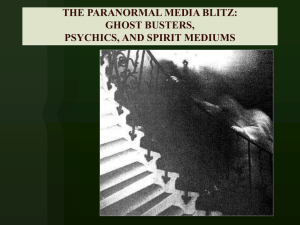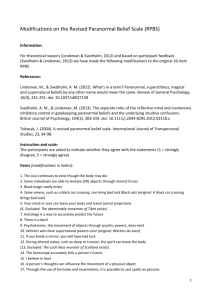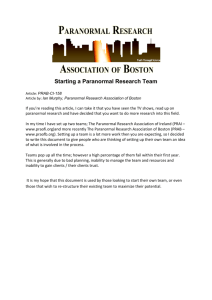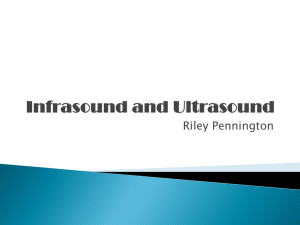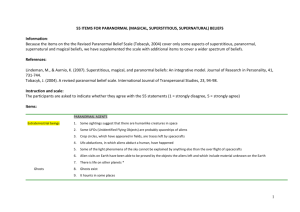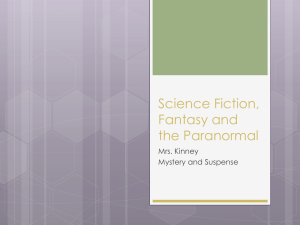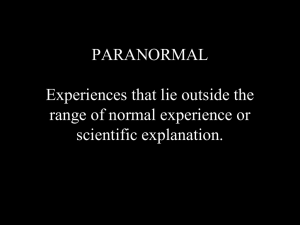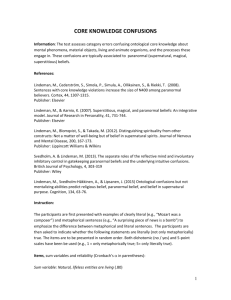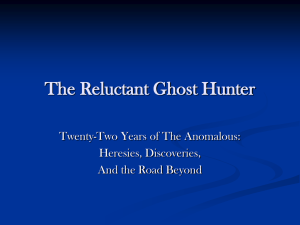The Evolution of Paranormal Research
advertisement
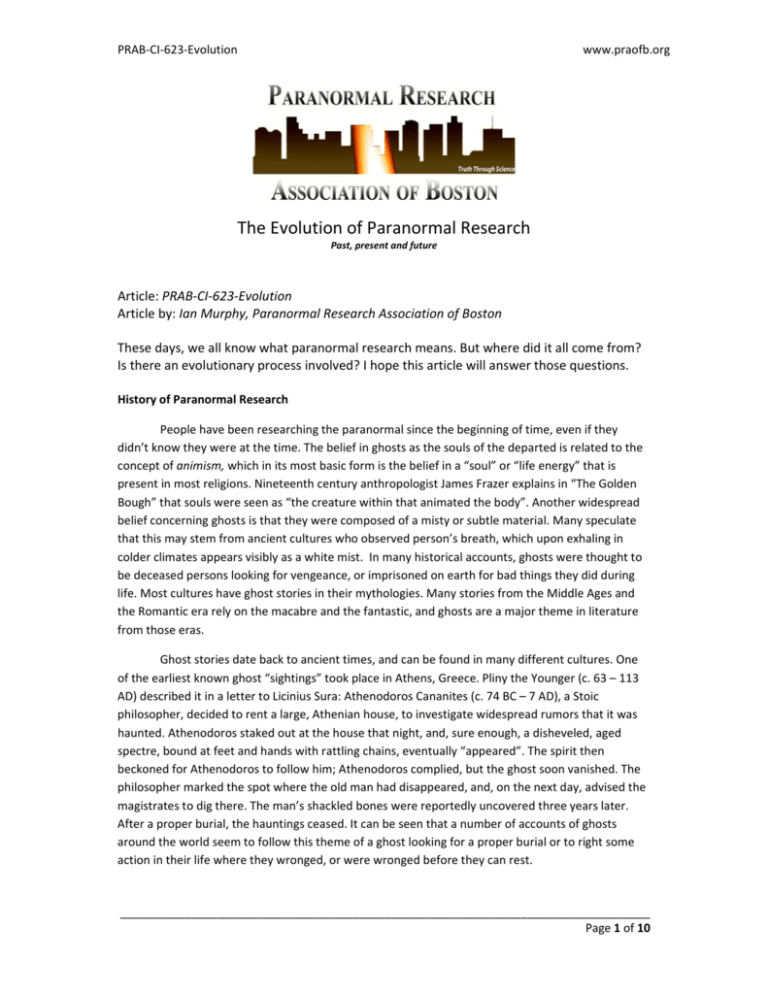
PRAB‐CI‐623‐Evolution www.praofb.org The Evolution of Paranormal Research Past, present and future Article: PRAB‐CI‐623‐Evolution Article by: Ian Murphy, Paranormal Research Association of Boston These days, we all know what paranormal research means. But where did it all come from? Is there an evolutionary process involved? I hope this article will answer those questions. History of Paranormal Research People have been researching the paranormal since the beginning of time, even if they didn’t know they were at the time. The belief in ghosts as the souls of the departed is related to the concept of animism, which in its most basic form is the belief in a “soul” or “life energy” that is present in most religions. Nineteenth century anthropologist James Frazer explains in “The Golden Bough” that souls were seen as “the creature within that animated the body”. Another widespread belief concerning ghosts is that they were composed of a misty or subtle material. Many speculate that this may stem from ancient cultures who observed person’s breath, which upon exhaling in colder climates appears visibly as a white mist. In many historical accounts, ghosts were thought to be deceased persons looking for vengeance, or imprisoned on earth for bad things they did during life. Most cultures have ghost stories in their mythologies. Many stories from the Middle Ages and the Romantic era rely on the macabre and the fantastic, and ghosts are a major theme in literature from those eras. Ghost stories date back to ancient times, and can be found in many different cultures. One of the earliest known ghost “sightings” took place in Athens, Greece. Pliny the Younger (c. 63 – 113 AD) described it in a letter to Licinius Sura: Athenodoros Cananites (c. 74 BC – 7 AD), a Stoic philosopher, decided to rent a large, Athenian house, to investigate widespread rumors that it was haunted. Athenodoros staked out at the house that night, and, sure enough, a disheveled, aged spectre, bound at feet and hands with rattling chains, eventually “appeared”. The spirit then beckoned for Athenodoros to follow him; Athenodoros complied, but the ghost soon vanished. The philosopher marked the spot where the old man had disappeared, and, on the next day, advised the magistrates to dig there. The man’s shackled bones were reportedly uncovered three years later. After a proper burial, the hauntings ceased. It can be seen that a number of accounts of ghosts around the world seem to follow this theme of a ghost looking for a proper burial or to right some action in their life where they wronged, or were wronged before they can rest. __________________________________________________________________________________ Page 1 of 10 PRAB‐CI‐623‐Evolution www.praofb.org Edison believed that the “soul” was made up of what he called “life units”. These microscopic particles or life units could rearrange into any form. They retained full memory, personality and were indestructible. Edison’s machine would detect these life units in the environment and allow living individuals to communicate with the dead. He put many years of hard work into his new creation, but sadly, he died before it was finished. Some people thought Edison was crazy. Others thought that he was onto something bigger than any of his other inventions. They believed that if he had a little more time, we might all today be living in a very different world. Attempts to apply modern scientific or investigative standards to the study of apparitional experiences began with the work of Edmund Gurney, Frederick William Henry Myers and Frank Podmore (1886), who were leading figures in the early years of the Society for Psychical Research. Their motive, as with most of the early work of the Society, was to provide evidence for human survival after death. For this reason they had a particular interest in what are known as ‘crisis cases’. These are cases in which a person has a quasi‐perceptual experience of someone at a distance at the time of that person’s death or other crisis. If the temporal coincidence of the crisis and the distant apparitional experience cannot be explained by any conventional means, then the presumption is made that some as yet unknown form of communication, such as telepathy (a term coined by Myers), has taken place. A notable later discussion of apparitional experiences was that of G.N.M. Tyrrell (1943). Tyrrell accepted the hallucinatory character of the experience, pointing out that it is virtually unknown for firsthand accounts to claim that apparitional figures leave any of the normal physical effects, such as footprints in snow, which one would expect of a real person. However, Tyrrell develops the idea that the apparition may be a way for the unconscious part of the mind to bring to consciousness information that has been paranormally acquired – in crisis cases, for example. He introduces an evocative metaphor of a mental ‘stage‐carpenter’, behind the scenes in the unconscious part of the mind, and constructing the quasi‐perceptual experience that eventually appears on the stage of consciousness, so that it embodies paranormal information in a symbolic way, a person drowning at a distance appearing soaked in water, for example. The study and discussion of apparitions took a different turn in the 1970s, with the work of Celia Green and Charles McCreery (1975). They were not primarily interested in the question of whether apparitions could shed any light on the existence or otherwise of telepathy, or in the survival question; instead they were concerned to analyze a large number of cases with a view to providing a taxonomy of the different types of experience, viewed simply as a type of anomalous perceptual experience or hallucination. Subjects of apparitional experiences are by no means always frightened by the experience; indeed they may find them soothing or reassuring at times of crisis or ongoing stress in their lives. Spontaneous apparitional experiences tend to happen in humdrum or everyday surroundings, and under conditions of low central nervous system arousal, most often in the subject’s own home – while doing housework, for example. By contrast, subjects who visit reputedly haunted locations in hopes of ‘seeing a ghost’ are more often than not disappointed. __________________________________________________________________________________ Page 2 of 10 PRAB‐CI‐623‐Evolution www.praofb.org Apparitions tend to be reported as appearing solid and not transparent; indeed they may be as realistic in a variety of ways as to deceive the percipient as to their hallucinatory nature; in some cases the subject only achieves insight after the experience has ended It is unusual for an apparitional figure to engage in any verbal interaction with the percipient; this is consistent with the finding that the majority of such experiences only involve one sense (most commonly the visual). Evolution of Paranormal Research In recent times, the last two decades, there have been numerous advances in the field. This is due to a number of reasons. Acceptance One of the most important reasons is acceptance of the subject. For a numerous years the subject of any paranormal conversation was generally taboo and kept behind closed doors. Although the subject is now not just accepted, but a source of entertainment; this change is due, in part, to the number of paranormal television shows that have been adorning our screen for the past few years. While people can argue these shows are fake or just for entertainment, no‐one can disagree that they have brought public interest to the field, which has enabled paranormal researchers access to more data and clients which they would not have had in the past. This data has been invaluable to our research, and enabled us to help many more clients. Theory and Research This has moved on to the evolution of equipment, as people are finding new ways to apply equipment to the field, which has sparked new research. Examples would include research into Infrasound and ElectroMagnetic Fields. __________________________________________________________________________________ Page 3 of 10 PRAB‐CI‐623‐Evolution www.praofb.org Electromagnetic Fields In the early 1990’s, a theory evolved that paranormal entities could manipulate the electromagnetic field. The theory proposed that the entity used the existing energy in a location and combine it in such as way as to raise and lower the intensity of the fields. This theory was used to ask a number of yes and no questions to the ghosts and spirits that were present in the room. This data was also used as proof of the spirits power and existence. This lead newer and more EMF detectors being manufactured and marketed to paranormal teams and individual researchers. EMF Detectors were originally used extensively in industry to test the radiation emitted from cell phone towers in the interest of public safety. From this, research was conducted on the effects of EMF on the human body. Some of this research includes: Public health implications of wireless technologies. Sage C, Carpenter DO. – 2009 Sage Associates, 1396 Danielson Road, Santa Barbara, CA 93108, USA. Disturbance of the immune system by electromagnetic fields‐A potentially underlying cause for cellular damage and tissue repair reduction which could lead to disease and impairment. Johansson O. ‐ 2009 The Experimental Dermatology Unit, Department of Neuroscience, Karolinska Institute, Stockholm, Sweden. Long‐term exposure to magnetic fields and the risks of Alzheimer's disease and breast cancer: Further biological research. Davanipour Z, Sobel E. ‐ 2009 Northwestern University, Feinberg School of Medicine, Chicago, IL, United States. Biological effects from electromagnetic field exposure and public exposure standards. Hardell L, Sage C. ‐ 2008 Department of Oncology, University Hospital, SE‐701 85 Orebro, Sweden. Bioinitiative Report – Section 5: Evidence for effects on neurology and behavior, Lai ‐2009 Department of Bioengineering. University of Washington, Seattle, Washington, USA Bioinitiative Report – Section 9: Evidence for Stress Response (Stress Proteins) Health Risk of Electromagnetic Fields: Research on the Stress Response, Blank ‐ 2009 Department of Physiology and Cellular Biophysics College of Physicians and Surgeons Columbia University When your neurochemistry is being affected by a high EMF field, it has been shown to cause you to see things, hear things, feel nervous or any other number of feelings or hallucinations. Once your __________________________________________________________________________________ Page 4 of 10 PRAB‐CI‐623‐Evolution www.praofb.org CNS is being misdirected by a high EMF field, it is entirely possible for your brain to attempt to make sense of the orders it is being given by creating any of the above phenomena. Most paranormal investigators, including the Paranormal Research Association of Boston, use meters that measure in mG (mili‐Gauss) or Gauss, which measures magnetic force. The field that surrounds an object is not linear; instead it is spherical, as with most forms of energy. It surrounds an object in a dome so to speak. The further away from the center of the EMF source you go, the readings dissipate exponentially. Studying this research, it is reasonable to determine that EMF, a previously unknown invisible energy, is a possible cause for phenomena reported. Infrasonics Infrasound is sound with a frequency too low to be heard by the human ear. The study of such sound waves is sometimes referred to as infrasonics, covering sounds beneath the lowest limits of human hearing (20 hertz) down to 0.001 hertz. This frequency range is utilized by characterized by an ability to cover long distances and get around obstacles with little dissipation. Infrasound has been known to cause feelings of awe or fear in humans. Since it is not consciously perceived, it can make people feel vaguely that paranormal events are taking place. History In 1998, computer specialist Vick Tandy from Coventry University always spent a lot of time in his laboratory. On one night, he suddenly broke into a cold sweat. He felt somebody was watching him with sinister eyes. Suddenly, a gray material form crossed the room and approached Vick. In the vague outline Vick could discern legs, arms and fog where the figure must have a head; there was a dark spot in the center of the fog which might be a mouth. The vision disappeared in the air without leaving a trace. Soon Vick Tandy managed to discover the factors quite accidentally. Vick's hobby, fencing helped him with it. Some time after the scientist saw the "ghost" he brought his rapier to the laboratory to set it right before a forthcoming fencing tournament. Suddenly Vick felt the blade gripped in a vice started vibrating more and more as if some invisible hand touched it. Vick suddenly arrived at a conclusion that the moving of the blade was resonance oscillations caused with sound waves. He measured the sound in the laboratory and was surprised to see that the sound in the room was incredibly loud; the sound waves were inaudible, but the oscilloscope detected a large amount of noise.. That was infrasound. It took the scientist a lot of time to find out the source of the infrasound; it was emitted by a recently set ventilator in the air conditioner. As soon as the air conditioner was switched off, the blade stopped vibrating. The same can be said for the crew of “The Flying Dutchmen”, ships that wandered around the seas without crews on board. The ships were in good repair, but there were no personnel on board. The mystery was unsolved for decades, until it became clear that infrasound was the explanation of the phenomenon. As it turned out, infrasound of seven hertz emitted by ocean waves under some definite conditions was the reason of it. But infrasound of seven hertz is terrible for people: they may go mad and throw themselves overboard __________________________________________________________________________________ Page 5 of 10 PRAB‐CI‐623‐Evolution www.praofb.org Further investigation of the phenomenon revealed that sound waves of this low frequency may appear rather frequently under natural conditions. Infrasound arises when strong gusts of wind clash with chimneys or towers. These heavy basses penetrate even through very thick walls. Such sound waves start rumbling in tunnel‐shaped corridors. Scientific studies (Infrasonic Research): On 31 May 2003, two concerts were staged, back to back, at the Purcell Room London. Each concert featured an hour of contemporary music for piano and electronics, performed by Genia and a new film piece by Ravi Deprees, specially created for the event. At four points during the show, the audience were asked to fill out a page of a questionnaire. This was designed to measure their emotional response to the music and log any unusual experiences (such as shivers down the spine). The questionnaire and psychology experiment were designed by psychologists Ciaran O’Keefe and Professer Richard Wiseman Just before two of these points, as the audience were absorbed in the film and music, the project team flooded the auditorium with infrasound. The infrasound was produced by a specially made generator and had a frequency of 17Hz. The two Purcell Room concerts were identical in every aspect, except the use of infrasound. If the generator was on in one piece in the 3pm show, it was off in that piece in the 5pm show (see which pieces had infrasound below). We were careful to use the infrasound at moderate levels so it would be on the cusp of perception. The music masked the infrasound ‐ in theory this meant the audience were never fully aware of its presence. Varying where we put the infrasound enables us to rule out the emotional effects of the other elements of the concert (the music, performance and film). During the concert, infrasound boosted the number of strange experiences reported among the audience, even among those who were unaware of its presence. Unusual reports included a sense of coldness, anxiety and shivers down the spine. On average, infrasound boosted the number of strange experiences by around 22%. It also increased the intensity of any feelings reported. Many unusual experiences were reported during the concerts, ranging from the emotional (e.g. ‘sense of sorrow’, ‘brief moment of anxiety’, ‘excited’) to the physiological (e.g. ‘increased heart‐rate’, ‘headache’, ‘tingling in neck and shoulders’, ‘nausea’, ‘sense of coldness’). The majority of reported experiences were physiological. __________________________________________________________________________________ Page 6 of 10 PRAB‐CI‐623‐Evolution www.praofb.org Which body parts are affected? Symptoms Abdominal pains General feeling of discomfort Influence on breathing Muscle contractions Chest pains Lower jaw symptoms Urge to urinate Limp in the throat Head symptoms Influence on speech Increased muscle tone Eye resonance Human auditory range Frequency (in Hz) 4 – 10 4 ‐ 9 4 – 8 4 – 9 5 – 7 6 – 8 10 – 18 12 – 16 13 – 20 13 – 20 13 – 20 16 – 19 20hZ – 20kHz Carbon Monoxide In the paranormal community, we a number of tools to measure the environment. One of the main reasons paranormal investigators do this is to attempt to explain a reason for perceived paranormal activity, and another is to be able to accurately recreate events. I will use carbon monoxide as a base for all forms of gasses that can create cerebral hypoxia, a lack of oxygen to the brain. A number of unfelt gasses cause this, and although their mechanism of action are different insomuch as they bond to different receptors and cells, their effects are similar. Carbon monoxide is a colorless, odorless, tasteless and toxic gas produced as a by‐product of combustion. Any fossil fuel burning appliance, vehicle, tool or other device has the potential to produce dangerous levels of carbon monoxide gas CO inhibits the blood's ability to carry oxygen to body tissues including vital organs such as heart and brain. When CO is inhaled, it combines with the oxygen carrying hemoglobin of the blood to form carboxyhemoglobin (COHb). Hemoglobin has a much higher affinity (240 times) for CO than oxygen (O2) therefore when you are in an environment that has CO in the air, when you breath in, you are more likely to take in and metabolize CO than O2. Once combined with the hemoglobin, that hemoglobin is no longer available for transporting oxygen as the CO molecules take the space that O2 should be occupying. Each hemoglobin molecule can hold up to 8 molecules of CO or O2 or a combination of both. Carboxyhaemoglobin also has direct effects on the blood vessels of the body ‐ causing them to become porous or 'leaky'. This is seen especially in the brain, causing the brain to swell, leading to unconsciousness and neurological damage. How quickly the carboxyhemoglobin builds up is a factor of the concentration of the gas being inhaled (measured in parts per million or PPM) and the duration of the exposure. Compounding the effects of the exposure is the long half‐life of carboxyhemoglobin in the blood. Half‐life is a measure of how quickly levels return to normal. The half‐life of carboxyhemoglobin is approximately 5 hours. This means that for a given exposure level, it will take about 5 hours for the level of carboxyhemoglobin in the blood to drop to half its current level after the exposure is terminated. __________________________________________________________________________________ Page 7 of 10 PRAB‐CI‐623‐Evolution CO levels and effects on the body www.praofb.org CO toxicity levels are usually expressed in airborne concentration levels (PPM) and duration of exposure. Expressed in this way, symptoms of exposure can be stated as follows: Symptoms Associated with a Given Concentration of COHb % COHb 10 15 25 30 45 50 Symptoms and Medical Consequences No symptoms. Heavy smokers can have as much as 9% COHb. Mild headache. Nausea and serious headache. Fairly quick recovery after treatment with oxygen and/or fresh air. Symptoms intensify. Potential for long term effects especially in the case of infants, children, the elderly, victims of heart disease and pregnant women Unconsciousness Death Psychology Psychological research and technique has improved significantly in the last 2 decades. Now, we are able to diagnose and treat a number of psychological issues that would one time have been looked on as “madness” and the experiences that people have reported that were assigned to paranormal phenomena. Publication of the fifth edition of Diagnostic and Statistical Manual of Mental Disorders (DSM‐V) in May 2013 will mark one the most anticipated events in the mental health field. DSM is published by the American Psychiatric Association (APA) and contains descriptions, symptoms, and other criteria for diagnosing mental disorders. These criteria for diagnosis provide a common language among clinicians – professionals who treat patients with mental disorders. By clearly defining the criteria for a mental disorder, DSM helps to ensure that a diagnosis is both accurate and consistent; for example, that a diagnosis of schizophrenia is consistent from one clinician to another, and means the same thing to both of these clinicians, whether they reside in the U.S. or other international settings. It is important to understand that appropriately using the diagnostic criteria found in DSM requires clinical training and a thorough evaluation and examination of an individual patient. DSM‐IV can be published from numerous sources. From reading it a number of mental disorders that mimic paranormal phenomena are discussed. I will not go into this in great detail as it is outside the scope of this paper, and much is common knowledge. __________________________________________________________________________________ Page 8 of 10 PRAB‐CI‐623‐Evolution www.praofb.org The Philip Experiment In the 1970s, a group of Canadian parapsychologists wanted to attempt an experiment to create a ghost, proving their theory that the human mind can produce spirits through expectation, imagination and visualization. The experiment took place in Toronto, Canada, in 1972, under the direction of the world‐renown expert on poltergeists, Dr A. R. G. Owen. What they came up with... was Philip The group's first task was to create their fictional historical character. Together they wrote a short biography of the person they named Philip Aylesford. Here, in part, is that biography: “Philip was an aristocratic Englishman, living in the middle 1600s at the time of Oliver Cromwell. He had been a supporter of the King, and was a Catholic. He was married to a beautiful but cold and frigid wife, Dorothea, the daughter of a neighboring nobleman. One day when out riding on the boundaries of his estates Philip came across a gypsy encampment and saw there a beautiful dark‐eyed girl raven‐haired gypsy girl, Margo, and fell instantly in love with her. He brought her back secretly to live in the gatehouse, near the stables of Diddington Manor ‐ his family home. For some time he kept his love‐nest secret, but eventually Dorothea, realizing he was keeping someone else there, found Margo, and accused her of witchcraft and stealing her husband. Philip was too scared of losing his reputation and his possessions to protest at the trial of Margo, and she was convicted of witchcraft and burned at the stake. Philip was subsequently stricken with remorse that he had not tried to defend Margo and used to pace the battlements of Diddington in despair. Finally, one morning his body was found at the bottom of the battlements, whence he had cast himself in a fit of agony and remorse.” The Owen group even enlisted the artistic talents of one of its members to sketch a portrait of Philip. With their creation's life and appearance now firmly established in their minds, the group began the second phase of the experiment: contact. In September 1972, the group began their "sittings" ‐ informal gatherings in which they would discuss Philip and his life, meditate on him and try to visualize their "collective hallucination" in more detail. These sittings, conducted in a fully lit room, went on for about a year with no results. Some members of the group occasionally claimed they felt a presence in the room, but there was no result they could consider any kind of communication from Philip. So they changed their tactics. The group decided they might have better luck if they attempted to duplicate the atmosphere of a classic spiritualist séance. They dimmed the room's lights, sat around a table, sang songs and surrounded themselves with pictures of the type of castle they imagined Philip would have lived in, as well as objects from that time period. It worked. During one evening's séance, the group received its first communication from Philip in the form of a distinct rap on the table. Soon Philip was answering questions asked by the group ‐ one rap for yes, two for no. They knew it was Philip because, well, they asked him. __________________________________________________________________________________ Page 9 of 10 PRAB‐CI‐623‐Evolution www.praofb.org The sessions took off from there, producing a range of phenomena that could not be explained scientifically. Through the table‐rapping communication, the group was able to learn finer details about Philip's life. He even seemed to exhibit a personality, conveying his likes and dislikes, and his strong views on various subjects, made plain by the enthusiasm or hesitancy of his knockings. His "spirit" was also able to move the table, sliding it from side to side despite the fact that the floor was covered with thick carpeting. At times it would even "dance" on one leg. While some would conclude that they prove that ghosts don't exist, that such things are in our minds only, others say that our unconscious could be responsible for this kind of the phenomena some of the time. They do not (in fact, cannot) prove that there are no ghosts, as you cannot prove a negative hypothesis. In any case, the experiments leave us with more questions than answers about the world in which we live. The only certain conclusion is that there is much to our existence that is still unexplained. A question posed to science every day. Derren Brown, a stage illusionist from England performed this experiment again in 2006 in a TV show called “Derren Brown – Séance” which showed similar results. From this research, investigators have been able to utilize this new information to incorporate into their theories. For example, we now see how a number of previously unknown forces can have an effect on the body that mimic paranormal phenomena. While some people will argue that this leads people to be more skeptical of paranormal claims, I believe it has an opposite effect. Because we are now able to take into account an increasing number of natural phenomena when investigating our client’s paranormal claims, when we cannot find these forces at work when an event is happening and documented, it makes our evidence and data stronger which has the effect of propelling paranormal science closer to being a well‐respected science. The Future of Paranormal Research What is the future of paranormal research? As with all fields of the unknown, the future is research and the people that drive that research. Paranormal teams will come and go. They will generally follow the normal path of a group of enthusiasts who investigate graveyards with little more than a video camera and a notebook, until they start studying the science and theory of the past, evolve their theories and then start to perform their own research and propose their own theories. So, the future of paranormal research is simple. It’s research, and most importantly, its you. __________________________________________________________________________________ Page 10 of 10
